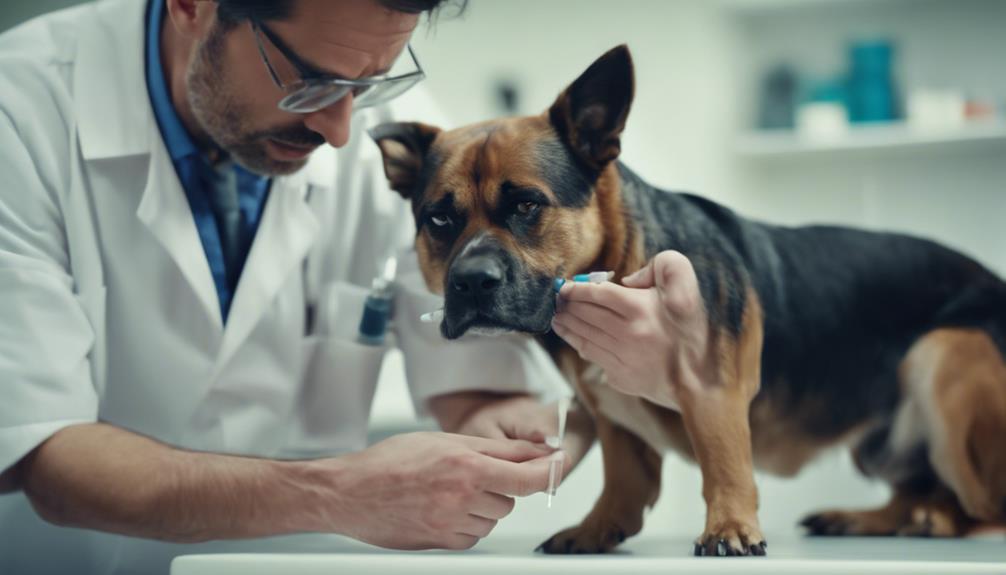In the realm of canine health, the persistent itch that plagues our furry companions can often be a perplexing issue for pet owners. Dog allergy testing emerges as a critical tool in unraveling the mysteries behind these incessant itches, shedding light on the specific triggers causing discomfort.
By delving into the intricacies of different testing approaches and methodologies, pet owners can gain valuable insights into their pup's allergies, paving the way for tailored treatment solutions. However, the journey to pinpointing the precise cause of your pup's itchiness is a multifaceted one, requiring a nuanced understanding and collaborative effort with veterinary professionals to navigate the complexities of canine allergies effectively.
Key Takeaways
- Atopy, contact allergies, insect bites, and respiratory allergies are common causes of dog itchiness.
- Allergy testing methods include intradermal testing, blood testing, elimination diets, and flea allergy testing.
- Intradermal testing is the gold standard for environmental allergies, requiring a detailed process for pinpointing triggers.
- Flea allergy testing is crucial if fleas are present, with treatment and prevention being key for symptom relief.
Understanding Dog Allergy Symptoms
Dog allergy symptoms can manifest in various forms depending on the allergen type and the dog's sensitivity level. Common signs include itching, redness, sneezing, coughing, wheezing, skin rashes, hives, and gastrointestinal issues.
Atopy, contact allergies, insect bites, respiratory allergies, and food allergies are primary culprits. Skin-related symptoms like itching and redness are often indicative of atopy or contact allergies, while coughing and wheezing may point towards respiratory allergies. Insect bites can result in localized swelling or hives. Additionally, food allergies can lead to gastrointestinal problems such as vomiting or diarrhea.
Understanding these symptoms is crucial for accurate diagnosis and effective management of dog allergies through appropriate testing and treatment methods.
Types of Dog Allergy Testing
Understanding the manifestation of various dog allergy symptoms is integral in determining the most appropriate types of allergy testing methods to accurately diagnose and manage canine allergies effectively. When it comes to dog allergy testing, there are several methods available to help pinpoint the specific allergen causing your pup's discomfort. Here are some key types of dog allergy testing to consider:
- Intradermal Testing: Provides detailed observations to pinpoint triggers.
- Blood Testing: Offers less invasive alternative with potential reliability concerns.
- Elimination Diet Method: Gold standard for food allergies, requiring dietary changes.
- Flea Allergy Testing: Helps diagnose if fleas are present, emphasizing prevention for symptom relief.
Each testing method plays a crucial role in identifying and managing your dog's allergies.
Intradermal Testing Process

The Intradermal Testing process is a meticulous procedure utilized as the gold standard for diagnosing environmental allergies in dogs. This method involves injecting small amounts of common environmental allergens under the skin to observe any allergic reactions. Here is a table outlining the key aspects of the Intradermal Testing process:
| Intradermal Testing Process | Details |
|---|---|
| Procedure | Injections of allergens under skin |
| Purpose | Diagnosing environmental allergies |
| Custom Serum | Formulated for desensitization |
| Suitability | Not for diagnosing food allergies |
Intradermal Testing provides detailed insights into specific allergens affecting your dog, enabling targeted treatment for their allergies.
Blood Testing Procedure
A commonly utilized method for allergy testing in canines involves a procedure known as blood testing. This less invasive approach entails drawing blood for allergen response analysis, aiding in the formulation of a custom allergy serum. While it offers convenience, there may be potential reliability concerns compared to intradermal testing. However, blood testing serves as a valuable alternative method to identify allergens in dogs.
- Discovering the allergen source through blood testing can bring relief to your furry companion.
- The process of drawing blood for analysis showcases the commitment to your pet's health.
- Custom allergy serum formulation demonstrates personalized care for your dog's specific allergies.
- Despite potential reliability concerns, blood testing remains a crucial step in the allergy testing process.
Importance of Elimination Diet Method

Utilizing the elimination diet method is paramount in accurately identifying and managing food allergies in dogs. This method involves feeding the dog a novel protein and carbohydrate source that they have not consumed before, such as duck and potato.
By eliminating potential allergens from the diet and then reintroducing them one by one, veterinarians can pinpoint the specific food trigger causing the allergic reactions. This process helps determine the exact ingredients that are causing adverse reactions in the dog's system.
It is crucial to strictly adhere to the elimination diet protocol and avoid any treats or flavored medications that could interfere with the accuracy of the results. Following this method diligently can lead to effective management and relief from food allergies in dogs.
Flea Allergy Diagnosis and Treatment
Flea allergy diagnosis and treatment are crucial aspects of managing allergic reactions in dogs. When dealing with flea allergies in your pup, it's essential to follow these key steps:
- Swift Identification: Finding and eliminating fleas promptly is vital for your dog's well-being.
- Medication Administration: Providing your dog with preventive flea medications can offer relief and prevent future allergic reactions.
- Symptom Monitoring: Keep a close eye on your dog for any signs of itching or discomfort even after treatment.
- Flea Prevention: Regularly use flea prevention methods to avoid future allergic episodes and maintain your dog's health and comfort.
Intradermal Testing Vs. Blood Testing

When comparing intradermal testing and blood testing for dog allergies, veterinary professionals often weigh the benefits and limitations of each diagnostic method. Intradermal testing is considered the gold standard for environmental allergies, requiring shaving for skin observations and offering custom allergy serum for desensitization. On the other hand, blood testing is less invasive, analyzing allergen responses through blood draws, and providing an alternative to intradermal testing. However, it may have potential reliability concerns compared to intradermal testing. Here is a comparison table highlighting key points of both testing methods:
| Intradermal Testing | Blood Testing |
|---|---|
| Gold standard for environmental allergies | Less invasive |
| Shaving required for skin observations | Blood drawn for analysis |
| Custom allergy serum for desensitization | Potential reliability concerns |
| Not suitable for food allergies | Alternative to intradermal testing |
Custom Allergy Serum Formulation
Considering the intricacies of allergy testing methods for dogs, the formulation of custom allergy serum plays a pivotal role in addressing specific allergens identified through diagnostic procedures. Custom allergy serum is tailored to the individual dog's allergies, helping to desensitize their immune system and alleviate symptoms.
Here are four reasons why custom allergy serum formulation is crucial for effective treatment:
- Personalized Approach: Tailored specifically to your dog's allergens.
- Targeted Treatment: Addresses the root cause of allergic reactions.
- Long-term Relief: Helps manage symptoms and improve quality of life.
- Professional Guidance: Administered under veterinary supervision for optimal results.
Flea Allergy Prevention Tips

Implementing proactive measures to prevent flea allergies in dogs is essential for maintaining their health and comfort. Regular grooming and bathing can help remove fleas and their saliva, a common allergen.
Using flea preventatives recommended by your veterinarian is crucial in controlling flea infestations. Vacuuming your home frequently, washing your pet's bedding in hot water, and treating your yard for fleas can also aid in preventing allergic reactions.
Additionally, keeping your dog away from known flea-infested areas and other animals that may carry fleas can reduce the risk of exposure.
Managing Multiple Allergies in Dogs
Managing multiple allergies in dogs requires a comprehensive approach to diagnosis and treatment to effectively alleviate symptoms and improve the quality of life for your pet. When faced with the challenge of managing multiple allergies in your beloved pup, consider the following emotional aspects:
- Empathy: Understand your dog's discomfort and the impact on their daily life.
- Patience: Dealing with multiple allergies may require time and effort to find the right treatment.
- Support: Provide a supportive environment for your dog throughout the treatment process.
- Hope: Stay positive and hopeful that with proper management, your furry friend can lead a happy and healthy life despite their allergies.
Consultation With Veterinary Experts

When faced with managing multiple allergies in your dog, seeking a consultation with veterinary experts is crucial for accurate diagnosis and effective treatment planning. Veterinary professionals have the expertise to conduct thorough assessments, recommend appropriate allergy testing methods, and interpret results accurately.
They can provide tailored advice on allergen avoidance strategies, medication options, and potential desensitization treatments based on your dog's specific needs. Additionally, veterinarians can help rule out other possible health conditions that may be contributing to your dog's symptoms, ensuring a comprehensive approach to managing your pup's allergies.
Effective Dog Allergy Management
Effectively addressing and controlling your dog's allergies requires a comprehensive approach tailored to their specific triggers and symptoms. To manage your pup's allergies successfully, consider the following emotional aspects:
- Empathy and Understanding: Recognize your dog's discomfort and frustration with itching and other allergy symptoms.
- Commitment to Treatment: Stay dedicated to implementing the allergy management plan consistently for your dog's well-being.
- Patience and Support: Be patient during the treatment process and provide emotional support to your furry companion.
- Celebrating Progress: Acknowledge and celebrate improvements in your dog's condition as a result of effective allergy management efforts.
Conclusion
In conclusion, accurate dog allergy testing methods such as intradermal testing, blood testing, and elimination diet protocols are essential for identifying allergens triggering adverse reactions in dogs.
Collaborating with veterinary professionals is crucial in developing tailored treatment plans for managing canine allergies effectively.
By utilizing a comprehensive approach to allergy testing and management, pet owners can enhance the well-being of their beloved furry companions and alleviate their discomfort.




